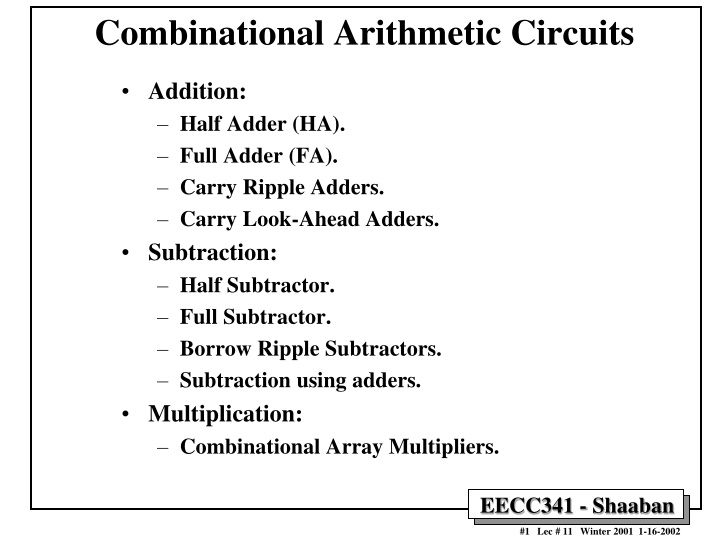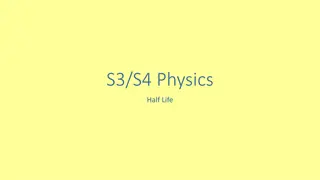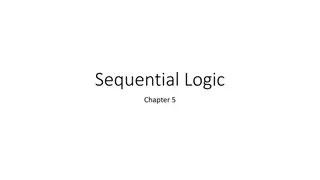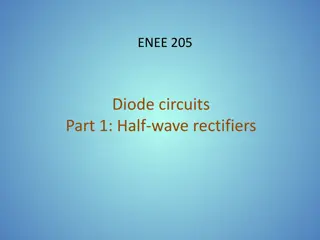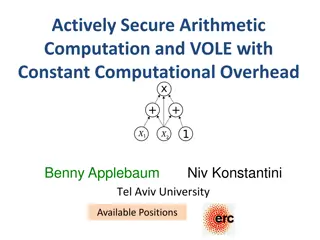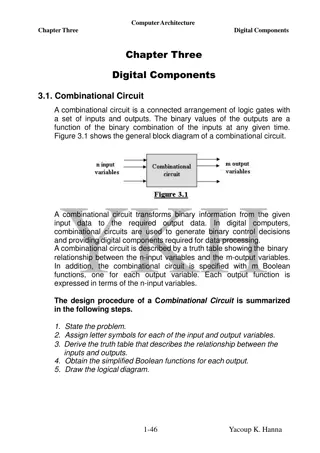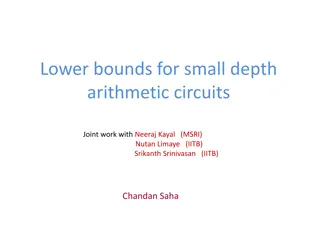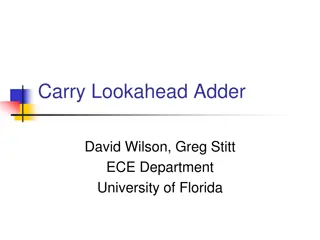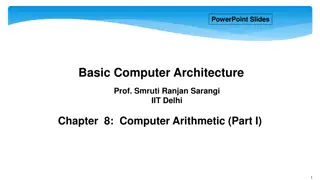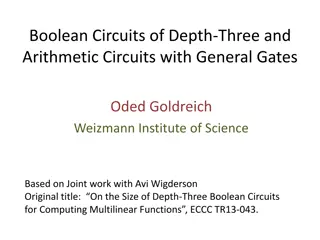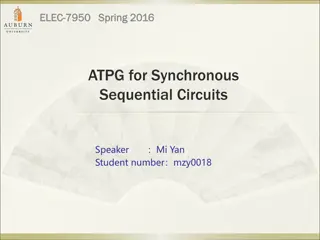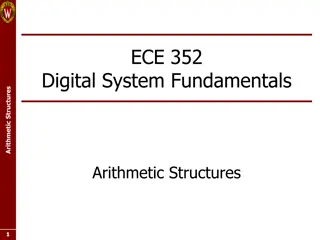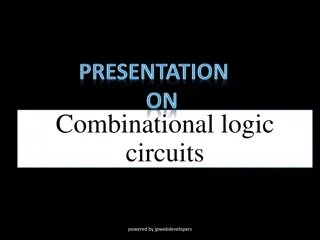Combinational Arithmetic Circuits: Half Adder, Full Adder, and More
Combinational arithmetic circuits play a crucial role in performing mathematical operations like addition, subtraction, and multiplication in digital systems. This includes understanding half adders, full adders, carry ripple adders, carry look-ahead adders, subtraction circuits, and array multipliers. The images and explanations provided offer insights into the functionality and implementation of these circuits.
Download Presentation

Please find below an Image/Link to download the presentation.
The content on the website is provided AS IS for your information and personal use only. It may not be sold, licensed, or shared on other websites without obtaining consent from the author.If you encounter any issues during the download, it is possible that the publisher has removed the file from their server.
You are allowed to download the files provided on this website for personal or commercial use, subject to the condition that they are used lawfully. All files are the property of their respective owners.
The content on the website is provided AS IS for your information and personal use only. It may not be sold, licensed, or shared on other websites without obtaining consent from the author.
E N D
Presentation Transcript
Combinational Arithmetic Circuits Addition: Half Adder (HA). Full Adder (FA). Carry Ripple Adders. Carry Look-Ahead Adders. Subtraction: Half Subtractor. Full Subtractor. Borrow Ripple Subtractors. Subtraction using adders. Multiplication: Combinational Array Multipliers. EECC341 - Shaaban #1 Lec # 11 Winter 2001 1-16-2002
Half Adder Adding two single-bit binary values, X, Y produces a sum S bit and a carry out C-out bit. This operation is called half addition and the circuit to realize it is called a half adder. Half Adder Truth Table S(X,Y) = (1,2) S = X Y + XY S = X Y Outputs Inputs X 0 0 1 1 Y 0 1 0 1 S 0 1 1 0 C-out 0 0 0 1 C-out(x, y, C-in) = (3) C-out = XY X Y Sum S X Half Adder S C-OUT C-out Y EECC341 - Shaaban #2 Lec # 11 Winter 2001 1-16-2002
Full Adder Adding two single-bit binary values, X, Y with a carry input bit C-in produces a sum bit S and a carry out C-out bit. Sum S X XY 00 01 11 10 2 1 C-in 6 0 4 1 0 Full Adder Truth Table 3 5 7 1 1 1 C-in 1 Outputs Inputs X 0 0 0 0 1 1 1 1 Y 0 0 1 1 0 0 1 1 C-in 0 1 0 1 0 1 0 1 S 0 1 1 0 1 0 0 1 C-out 0 0 0 1 0 1 1 1 Y S = X Y (C-in) + XY (C-in) + XY (C-in) + XY(C-in) S = X Y (C-in) Carry C-out X XY 00 01 11 10 2 C-in 6 0 4 1 0 3 5 7 1 1 1 1 C-in 1 Y S(X,Y, C-in) = (1,2,4,7) C-out(x, y, C-in) = (3,5,6,7) C-out = XY + X(C-in) + Y(C-in) EECC341 - Shaaban #3 Lec # 11 Winter 2001 1-16-2002
Full Adder Circuit Using AND-OR X Y X Y C-in X X X C-in X Y Sum S X YC-in Y C-in Y Y X Y C-in C-in XY C-in C-in C-in X Y XYC-in C-in X Y X XY Y Full Adder C-out C-in X XC-in C-out C-in Y S YC-in C-in EECC341 - Shaaban #4 Lec # 11 Winter 2001 1-16-2002
Full Adder Circuit Using XOR X Sum S Y X Y C-in Full Adder X XY C-out C-in Y X XC-in C-out S C-in Y YC-in C-in EECC341 - Shaaban #5 Lec # 11 Winter 2001 1-16-2002
n-bit Carry Ripple Adders An n-bit adder used to add two n-bit binary numbers can built by connecting in series n full adders. Each full adder represents a bit position j (from 0 to n-1). Each carry out C-out from a full adder at position j is connected to the carry in C-in of the full adder at the higher position j+1. The output of a full adder at position j is given by: Sj = Xj Yj Cj Cj+1 = Xj . Yj + Xj . Cj + Y . Cj In the expression of the sum Cj must be generated by the full adder at the lower position j-1. The propagation delay in each full adder to produce the carry is equal to two gate delays = 2 Since the generation of the sum requires the propagation of the carry from the lowest position to the highest position , the total propagation delay of the adder is approximately: Total Propagation delay = 2 n EECC341 - Shaaban #6 Lec # 11 Winter 2001 1-16-2002
4-bit Carry Ripple Adder Inputs to be added Adds two 4-bit numbers: X = X3 X2 X1 X0 Y = Y3 Y2 Y1 Y0 producing the sum S = S3 S2 S1 S0 , C-out = C4 from the most significant position j=3 X3X2X1X0 Y3Y2Y1Y0 4-bit Adder C4 C0 =0 C-in C-out Total Propagation delay = 2 n = = 8 S3 S2 S1 S0 or 8 gate delays Sum Output Data inputs to be added X3 Y3 X2 Y2 X1 Y1 X0 Y0 Full Adder Full Adder Full Adder Full Adder C3 C2 C1 C4 C0 =0 C-in C-in C-in C-in C-out C-out C-out C-out S3 S2 S1 S0 Sum output EECC341 - Shaaban #7 Lec # 11 Winter 2001 1-16-2002
Larger Adders Example: 16-bit adder using 4, 4-bit adders Adds two 16-bit inputs X (bits X0 to X15), Y (bits Y0 to Y15) producing a 16-bit Sum S (bits S0 to S15) and a carry out C16 from most significant position. Data inputs to be added X (X0 to X15) , Y (Y0-Y15) Y3Y2Y1Y0 Y3Y2Y1Y0 Y3Y2Y1Y0 Y3Y2Y1Y0 X3X2X1X0 X3X2X1X0 X3X2X1X0 X3X2X1X0 4-bit Adder 4-bit Adder 4-bit Adder 4-bit Adder C12 C8 C4 C16 C0 =0 C-in C-in C-in C-in C-out C-out C-out C-out S3 S2 S1 S0 S3 S2 S1 S0 S3 S2 S1 S0 S3 S2 S1 S0 Sum output S (S0 to S15) Propagation delay for 16-bit adder = 4 x propagation delay of 4-bit adder = 4 x 2 n = = x8 = or 32 gate delays EECC341 - Shaaban #8 Lec # 11 Winter 2001 1-16-2002
Carry Look-Ahead Adders The disadvantage of the ripple carry adder is that the propagation delay of adder (2 n ) increases as the size of the adder, n is increased due to the carry ripple through all the full adders. Carry look-ahead adders use a different method to create the needed carry bits for each full adder with a lower constant delay equal to three gate delays. The carry out C-out from the full adder at position i or Cj+1 is given by: C-out = C i+1 = Xi . Yi + (Xi + Yi) . Ci By defining: Gi = Xi . Yi as the carry generate function for position i (one gate delay) (If Gi =1 C i+1 will be generated regardless of the value Ci) Pi = Xi + Yi as the carry propagate function for position i (one gate delay) (If Pi = 1 Ci will be propagated to C i+1) By using the carry generate function Gi and carry propagate function Pi , then C i+1 can be written as: C-out = C i+1 = Gi + Pi . Ci To eliminate carry ripple the term Ci is recursively expanded and by multiplying out, we obtain a 2-level AND-OR expression for each C i+1 EECC341 - Shaaban #9 Lec # 11 Winter 2001 1-16-2002
Carry Look-Ahead Adders For a 4-bit carry look-ahead adder the expanded expressions for all carry bits are given by: C1 = G0 + P0.C0 C2 = G1 + P1.C1 = G1 + P1.G0 + P1.P0.C0 C3 = G2 + P2.G1 + P2.P1.G0 + P2.P1.P0.C0 C4 = G3 + P3.G2 + P3.P2.G1 + P3 .P2.P1.G0 + P3.P2.P1.P0.C0 where Gi = Xi . Yi Pi = Xi + Yi The additional circuits needed to realize the expressions are usually referred to as the carry look-ahead logic. Using carry-ahead logic all carry bits are available after three gate delays regardless of the size of the adder. EECC341 - Shaaban #10 Lec # 11 Winter 2001 1-16-2002
Carry Look-Ahead Circuit Ci = Gi-1 + Pi-1. Gi-2+ . + Pi-1.P i-2. P1 . G0 + P i-1.P i-2. P0 . C0 EECC341 - Shaaban #11 Lec # 11 Winter 2001 1-16-2002
Binary Arithmetic Operations Subtraction Two binary numbers are subtracted by subtracting each pair of bits together with borrowing, where needed. Subtraction Example: 0 0 1 1 1 1 1 0 0 Borrow X 229 1 1 1 0 0 1 0 1 Y - 46 - 0 0 1 0 1 1 1 0 183 1 0 1 1 0 1 1 1 EECC341 - Shaaban #12 Lec # 11 Winter 2001 1-16-2002
Half Subtractor Subtracting a single-bit binary value Y from anther X (I.e. X -Y ) produces a difference bit D and a borrow out bit B-out. This operation is called half subtraction and the circuit to realize it is called a half subtractor. Half Subtractor Truth Table D(X,Y) = (1,2) D = X Y + XY D = X Y Outputs Inputs X 0 0 1 1 Y 0 1 0 1 D 0 1 1 0 B-out 0 1 0 0 B-out(x, y, C-in) = (1) B-out = X Y Difference D X Y X Half D B-OUT B-out Subtractor Y EECC341 - Shaaban #13 Lec # 11 Winter 2001 1-16-2002
Full Subtractor Subtracting two single-bit binary values, Y, B-in from a single-bit value X produces a difference bit D and a borrow out B-out bit. This is called full subtraction. Full Subtractor Truth Table Inputs Difference D XY X 00 01 11 10 2 1 B-in 6 0 4 1 0 3 5 7 1 1 1 B-in 1 Outputs X 0 0 0 0 1 1 1 1 Y 0 0 1 1 0 0 1 1 B-in 0 1 0 1 0 1 0 1 D 0 1 1 0 1 0 0 1 B-out 0 1 1 1 0 0 0 1 Y S = X Y (B-in) + XY (B-in) + XY (B-in) + XY(B-in) S = X Y (C-in) Borrow B-out X XY 00 01 11 10 2 1 B-in 6 0 4 0 3 5 7 1 1 1 1 B-in 1 Y S(X,Y, C-in) = (1,2,4,7) C-out(x, y, C-in) = (1,2,3,7) B-out = X Y + X (B-in) + Y(B-in) EECC341 - Shaaban #14 Lec # 11 Winter 2001 1-16-2002
Full Subtractor Circuit Using AND-OR X Y X Y B-in X X X B-in X Y Difference D X YB-in Y B-in Y Y X Y B-in B-in XY B-in B-in B-in X Y XYB-in B-in X Y X X Y Y Full B-out B-in X X B-in B-out Subtractor B-in Y D YB-in B-in EECC341 - Shaaban #15 Lec # 11 Winter 2001 1-16-2002
Full Subtractor Circuit Using XOR X Difference D Y X Y B-in Full X X Y B-out B-in Subtractor Y X X B-in B-out D B-in Y YB-in B-in EECC341 - Shaaban #16 Lec # 11 Winter 2001 1-16-2002
n-bit Subtractors An n-bit subtracor used to subtract an n-bit number Y from another n-bit number X (i.e X-Y) can be built in one of two ways: By using n full subtractors and connecting them in series, creating a borrow ripple subtractor: Each borrow out B-out from a full subtractor at position j is connected to the borrow in B-in of the full subtracor at the higher position j+1. By using an n-bit adder and n inverters: Find two s complement of Y by: Inverting all the bits of Y using the n inverters. Adding 1 by setting the carry in of the least significant position to 1 The original subtraction (X - Y) now becomes an addition of X to two s complement of Y using the n-bit adder. EECC341 - Shaaban #17 Lec # 11 Winter 2001 1-16-2002
4-bit Borrow Ripple Subtractor Inputs X3X2X1X0 Y3Y2Y1Y0 Subtracts two 4-bit numbers: Y = Y3 Y2 Y1 Y0 from X = X3 X2 X1 X0 Y = Y3 Y2 Y1 Y0 producing the difference D = D3 D2 D1 D0 , B-out = B4 from the most significant position j=3 4-bit B4 B0 =0 B-in B-out Subtractor D3 D2 D1 D0 Difference Output D Data inputs to be subtracted X3 Y3 X2 Y2 X1 Y1 X0 Y0 B3 B2 B1 Full B4 Full Full B0 =0 B-in B-in B-in B-in Full B-out B-out B-out B-out Subtractor Subtractor Subtractor Subtractor D3 D2 D1 D0 Difference output D EECC341 - Shaaban #18 Lec # 11 Winter 2001 1-16-2002
4-bit Subtractor Using 4-bit Adder Inputs to be subtracted Y3 Y2 Y1 Y0 X3 X2 X1 X0 4-bit Adder C4 C0 = 1 C-out C-in S3 S2 S1 S0 D3 D2 D1 D0 Difference Output EECC341 - Shaaban #19 Lec # 11 Winter 2001 1-16-2002
Binary Multiplication Multiplication is achieved by adding a list of shifted multiplicands according to the digits of the multiplier. Ex. (unsigned) 11 1 0 1 1 multiplicand (4 bits) X 13 X 1 1 0 1 multiplier (4 bits) -------- ------------------- 33 1 0 1 1 11 0 0 0 0 ______ 1 0 1 1 143 1 0 1 1 --------------------- 1 0 0 0 1 1 1 1 Product (8 bits) X3 X2 X1 X0 x Y3 Y2 Y1 Y0 __________________________ X3.Y0 X2.Y0 X1.Y0 X0.Y0 X3.Y1 X2.Y1 X1.Y1 X0.Y1 X3.Y2 X2.Y2 X1.Y2 X0.Y2 X3.Y3 X2.Y3 X1.Y3 X0.Y3 _______________________________________________________________________________________________________________________________________________ P7 P6 P5 P4 P3 P2 P1 P0 An n-bit X n-bit multiplier can be realized in combinational circuitry by using an array of n-1 n-bit adders where is adder is shifted by one position. For each adder one input is the multiplied by 0 or 1 (using AND gates) depending on the multiplier bit, the other input is n partial product bits. EECC341 - Shaaban #20 Lec # 11 Winter 2001 1-16-2002
4x4 Array Multiplier EECC341 - Shaaban #21 Lec # 11 Winter 2001 1-16-2002
